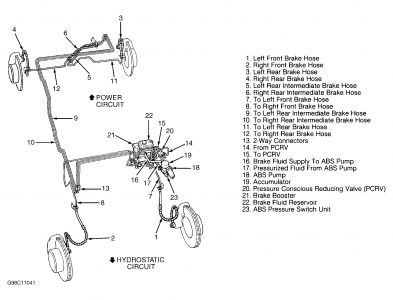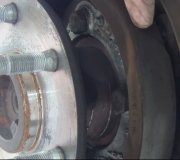The ABS system has it's own control module and should tell you where the actual fault lies with a diagnostic scanner !
The brake system features a hydraulic brake booster/ABS modulator unit, front/rear split hydraulic circuit, 2-piston front calipers and single-piston rear calipers. The hydraulic brake booster/ABS modulator unit is mounted in same position as conventional vacuum booster/master cylinder assembly and serves much of the same function. The hydraulic brake booster/ABS modulator unit contains a fluid reservoir, power valve, master cylinder, isolating valve, ABS control valves, servo cylinders and Electronic Traction Control (ETC) solenoid control valves.
Mounted on top of the hydraulic brake booster/ABS modulator unit, the plastic reservoir is subdivided internally to provide separate capacity for brake fluid used in the hydrostatic and power circuits. A central tube incorporates a filter. A built in fluid level warning switch and a finer filter for the power circuit fluid are also incorporated. The fluid level warning switch is closed when there is sufficient fluid in reservoir.
Operation of the master cylinder displaces a volume of brake fluid into the servo cylinders and increases fluid pressure. Piston movement inside the master cylinder will also activate the power valve.
The power valve is an extension of the master cylinder. It controls fluid pressure in the power circuit in direct proportion to pressure in the master cylinder. The power valve is of spool valve design.
The isolating valve consists of two solenoid valves controlling fluid inlet and outlet. Their function is to disconnect the master cylinder from the servo cylinders and to connect the servo cylinders to the reservoir return during ABS function.
Front calipers are supplied by the combined hydrostatic (master cylinder) and power (ABS pump) circuits. Rear calipers are supplied by the power circuit. For schematic of complete hydraulic circuit, including ABS portion, see Fig. 1 .
Parking brake is a single drum brake assembly mounted on the rear of the transfer case output shaft. Parking brake acts on rear driveshaft, and is cable-actuated by hand brake lever.
Fig. 1: Identifying ABS Hydraulic Brake Circuits & Components

Thursday, February 26th, 2009 AT 5:26 AM



